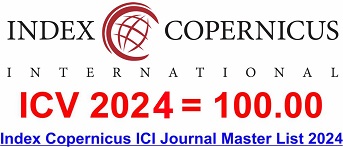REAL EFFECTIVE EXCHANGE RATE OF INDIA: PATTERNS AND DETERMINANTS
Abstract
In this paper, author endeavors to establish the patterns and trends of Real Effective Exchange Rate of India during 1970-2015 and tries to show the determinants of REER e.g., growth rate, current account deficit as percent of GDP, percent of openness, foreign direct investment inflows, and foreign exchange reserves excluding gold. The author used semi-log, double log linear and exponential model, autoregression, ARIMA, GARCH models for trends and volatility. Bai and Perron (2003) model was applied to show structural breaks and Hodrick and Prescott (1997 ) model was applied for smoothness of cyclical trend. Johansen (1988, 1991, 1996) models were used to fit co-integration test and vector error corrections. Residual tests were done to verify autocorrelations, normality and impulse response functions were found to show stability and convergence.
The paper concludes that REER has been declining at the rate 0.4085 percent per year which is insignificant at 5% level during 1970-2015 but it is exponentially declining at the rate of 0.2028 percent which is significant. AR(1) of REER is convergent, stationary and significant but AR(2) is convergent, non-stationary and insignificant. Even ARIMA(1,1,1) is non-stationary because AR(1) is stationary but MA(1) is non-stationary. GARCH(1,1) showed insignificant. Thus the series REER is highly volatile. This series contains five significant structural breaks in 1976, 1986, 1992, (downward) 2004 and 2010 (upward). Its pattern is cyclical which was turned to smooth cycle. Trace statistic showed three cointegrating vectors and Max-Eigen Statistic showed two cointegrating vectors that verify cointegration in the order one. Vector Error Correction model is stable because all roots lie in the unit root circle but it is non-stationary because impulse response functions are diverging and error corrections are significant only in degree of openness and FDI inflows in relating REER during 1970-2015 with one period lag. Residuals test of VECM confirmed non normality and autocorrelations.
Only sound fiscal and monetary policy can control upward movement of REER so that significant relationships can be achieved with those selected determinants that would spur the growth of international trade.
Keywords:
Real Effective Exchange Rate, Stationary, Structural Breaks, Causality, Co-integration, Vector Error CorrectionDownloads
References
Gandolfo, G. & Nicoletti, G. (2002). Exchange rate volatility and economic openness: A causal relation? Working Papers 68, Sapienza University of Rome, CIDEI.
Granger, C.W.J. (1969). Investigating Causal Relations byEconometricModelsandCross-spectral Methods, Econometrica, 37(3), pp 424 - 438.
Habib, M.M., Elitza, M. & Stracca, L. (2016). The Real Exchange Rate and Economic Growth: Revisiting the case using external instruments, ECB Working Paper Series 1921.
Haddad, M.E., Lim, J.J. & Christian, S. (2013). Trade openness reduces growth volatility when countries are well diversified. Canadian Journal of Economics, Canadian Economics Association, 46(2), pp 765-790.
Hau, H. (2002). Real Exchange Rate Volatility and EconomicOpenness:TheoryandEvidence, Journal of Money, Credit, and Banking, 34(3), pp 1-22.
Hodrick, R.J. & Prescott, E.C. (1997). Post War US BusinessCycles:AnEmpiricalInvestigation, Journal of Money, Credit and Banking, 29(1), pp 1-16.
Johansen, S. (1988). Statistical Analysis of Co-integrating Vectors. Journal of Economic Dynamics and Control, 12(2-3), pp 231-254.
Johansen, S. (1991). Estimation of Hypothesis Testing of Co-integration Vectors in Gaussian Vector Autoregressive Models, Econometrica, 59(6), pp 1551-80.
Johansen, S. (1996). Likelihood-Based Inference in Co-integrated Vector Autoregressive Models, 2nd Edition, Oxford University Press, UK.
Jushan, B. & Perron, P. (2003). Critical values for multiple structural change tests. Econometrics Journal, 6, pp 72-78.
Khan, M.T. (2013). Exchange rate as a determinant of fluctuation in foreign exchange reserves: Evidence from economy of Pakistan, Social Sciences and Humanities, 4(2), pp 459-471.
Kharroubi, E. (2011). The Trade Balance and the Real Exchange Rate, BIS Quarterly Review, September 2011, pages 10.
Munthali, T., Simwaka, K. & Mwale, M. (2010). The real exchange rate and growth in Malawi: Exploring the transmission route. Journal of Development and Agricultural Economics, 2(9), pp 303-315.
Nguyen, T.P. & Nguyen, D.T. (2010). Vietnam's Exchange Rate Policy and Implications for its Foreign Exchange Market, 1986-2009. Griffith University, Australia. pp1-31.
Papaioannou, E. & Portes, R. (2008). Costs and Benefits of Running an International Currency, European Commission. DG-EC/FIN, Special Report on the European Economy, European Economy Economic Papers No. 348.
Romelli, D., Terra, C. & Vasconcelos, E. (2014). Current Account and Real Exchange Rate Changes: The Impact of Trade Openness. ESSEC Working Paper 1520. Available at: https://ssrn.com/abstract=2439832
Yaya, M.E. & Xiaoxia, L. (2012). The Short-Run Relationship between Real Effective Exchange Rate and Balance of Trade in China, International Journal of Applied Economics, 9(1), pp 15-27.
Yusoff, M.B. & Febrina, Y.I. (2014). Trade Openness, Real Exchange Rate, Gross Domestic Investment, and Growth in Indonesia, The Journal of Applied Economic Research, 8(1), pp 1-13.
Downloads
Published
How to Cite
Issue
Section
License
Copyright (c) 2017 International Journal on Recent Trends in Business and Tourism (IJRTBT)

This work is licensed under a Creative Commons Attribution-NonCommercial-NoDerivatives 4.0 International License.



























